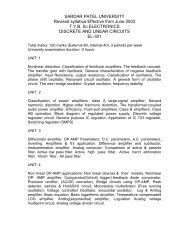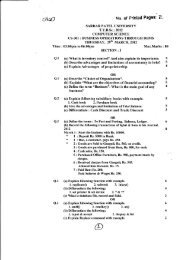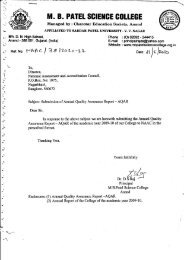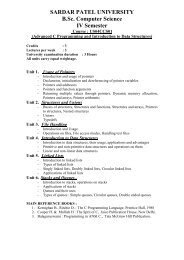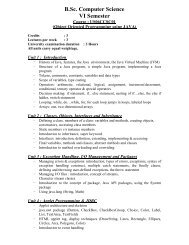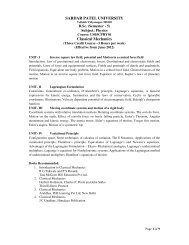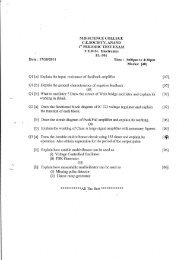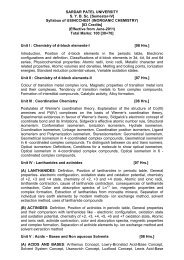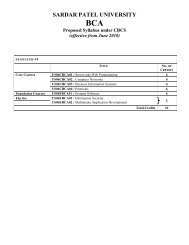Chemistry - MB Patel Science College
Chemistry - MB Patel Science College
Chemistry - MB Patel Science College
- No tags were found...
Create successful ePaper yourself
Turn your PDF publications into a flip-book with our unique Google optimized e-Paper software.
Unit–VAUnit-VBUnit-VIAUnit-VIBWilkinson and P. L. Gaus 417-434,451-463Selected Topics in inorganic <strong>Chemistry</strong>200 – 217Wahid U.Malik,G.D.Tuli and R.D. MadanAdvance Inorganic<strong>Chemistry</strong>(18 th Edition)(Vol.II),Satya 856-869Prakash, G.D.Tuli,S.K.Basu and R.D.MadanSelected Topic in inorganic <strong>Chemistry</strong> 218-249Text Book of Inorganic <strong>Chemistry</strong> (20 th Edition),P.L.Soni & Mohan Katyal.Chapter 15(2.60to2.83)
SARDAR PATEL UNIVERSITYS.Y.B.Sc C-202(Physical <strong>Chemistry</strong>)(Effective from june-2007)Unit-1: Ionic Equilibrium in aqueous solutions(14 Marks)1.1. Sparingly Soluble salts1.2. Selective Precipitation1.3. Acids and bases1.4. The P H Scale1.5. Weak acids and bases1.6. Hydrolysis1.7. Buffer Solutions1.8. Indicators1.9. Numerical problemsReference book : University <strong>Chemistry</strong> by Bruce H. Mahan(Page No. 204 to 234)Unit -2 : Solution and colligative properties(13 Marks)2.1 Solution2.2 Ideal solution2.3 Real solution2.4 Colligative properties2.5 Osmosis and Osmotic Pressure (with relative lowering of vapour pressure)2.6 Elevation of boiling point and depression of freezing point2.7 Real gases and some applications2.8 Numerical problemsReferance book: Physical <strong>Chemistry</strong> Volume 1 by Dr. S. Pahari(Page No. 415to456)Unit-3: Electrolytes in solution (13 Marks)3.1 Specific Conductance3.2 Molar conductance3.3 Conductance and Electrolytic Dissociation3.4 Colligative properties and Electrolytic Dissociation3.5 Electrolysis3.6 Transference numbers3.7 Ionic Mobilities3.8 Applications3.9 Dielectric Effect3.10 Ionic strength3.11 Dissociation of weak Electrolysis3.12 Deby-Huckel Theory3.13 Numerical Problems
Reference books: 1.Physical chemistry 5 th edition by Gordon. M. Barrow(Page No.303 to 332)Unit -4: Liquid State (14 Marks)4.1 Introduction4.2 Properties of Liquids4.3 Vapour Pressure of Liquids4.4 Surface Tension4.5 Viscosity4.6 Numerical ProblemsReference Book: 1.Physical <strong>Chemistry</strong> Volume 1 by Dr. S. Pahari(Page No, 133 to 165)Unit-5: Electromotive force of Electrochemical Cells(13 Marks)5.1 Electrodes5.2 Cell EMF5.3 EMF and Free Energy5.4 Standard Electrode Potentials5.5 EMF and Activities5.6 Activity Coefficients from EMF’s5.7 Equilibrium constants from EMF’s5.8 Electrode-Concentration Cells5.9 Electrolyte-Concentration Cells5.10 Junction Potentials5.11 Salt Bridge5.12 Ion-Selective Electrodes5.13 Thermodynamic Properties from Cell EMF’s5.14 Numerical ProblemsReference Books: 1.Physical <strong>Chemistry</strong> 5 th Edition by GordonM.Barrow (PageNo 346 to 373)Unit -6 : Entropy and Third Law of Thermodynamics(13 Marks)6.1 Third Law of thermodynamics6.2 Molecular Basis of Entropy6.3 Translation Entropy6.4 Rotational Entropy6.5 Vibrational Entropy6.6 Molecular Basis of the Third Law6.7 Trouton’s Rule6.8 Free Energy6.9 Standard Free Energies of Formation6.10 Free Energy and Pressure6.11 Free Energy and Equilibrium Constant
6.12 Free Energy and Temperature6.13 Free Energy Function6.14 Equilibria and distributions6.15 Fugacity6.16 Free Energy of Real Gases6.17 Equilibria Involving Real Gases6.18 Numerical problemsReference Books: 1.Physical <strong>Chemistry</strong> 5 th Edition by Gordon M. Barrow(Page 196 to 206 and 215 to 245)
SARDAR PATEL UNIVERSITYS.Y.B.Sc C-203(<strong>Chemistry</strong> Practical)(Effective from june-2007)Total : 120 MarksTime : 6 &1/2 Hr.1. INORGANIC MIXTURE :(Four radicals) It may include two positive radicalsand two negative radicals.25 Marks2. BINARY ORGANIC MIXTURE : (solid + solid or Solid + Liquid i.e. Acetone,methyl acetate,methanol,ehanol,CCL 4)25 Marks3. VOLUMETRIC TITRATION: 15 MarksI. Determination of equivalent weight of carboxylic acid by alkali solution.II. Determination of glucose.III. Determination of formaldehyde by sodium Hypoiodide.IV. Estimation of copper by iodometric method.V. Determination of total hardness of water sample.VI. Determination of nickel by back titration.VII. Determination of nitride by back titration.VIII. Determination of calcium as a calcium oxalate by KMnO 44. GRAVIMETRIC ANALYSIS: 10 MarksI. ZnCO 3II. ZnCO 3 +ZnOIII. BaCl 2 .2H 2 oIV. Na 2 Co 3 +NaHCO 3V. BaSO 4 +NH 4 Cl5. Preparation of standared solutions.6. TLC and paper chromatography.7. VIVAVOCE 5 Marks
SARDAR PATEL UNIVERSITYS. Y. B. Sc.ANALYTICAL CHEMISTRY (AC-201)CLASSICAL METHODS OF ANALYSIS(Effective from june-2007)(3 HOURS-80 MARKS)UNIT: 1Analytical chemistry: Qualitative and Quantitative analysis, AnalyticalMethodology, Applications of Chemical Analysis.Errors and Treatment of Analytical data: Determinate error andindeterminate error; Accuracy and Precision, Distribution of RandomError.Statistical Tretment of Finite samples: Measure of central tendency,Student’s t-test, Confidence interval of the mean, Testing forsignificance criteria for Rejection of an observation, Propagation oferrors, significant figures.Numericals.UNIT: II Chemical Equilibrium:Equilibrium constant, Le-Chatelier Braun Principle, Factor AffectingChemical Equilibrium in Solution, Activity and Activity coefficient,DebyeHuckel Equation for activity coefficient, strong and weakelectrolyte,Solubility product, common ion effect and diverse ion effectNumericals.UNIT: III Titrimetric methods of analysis:Introduction to Titrimetric methods and basic term involved, types ofchemical reactions used in Titrimetric analysis, requirements of areaction to be used in titration, concentration units used in titrationmolarity, molality, formality, primary and secondary standards.Neutralization Titration:Neutralization reaction and its equilibrium, indicators :phenolphthalein,methyl orange, buffer solution, colour change pH range of an indicator,mixed indicator, universal indicator ,neutralization curve for strong acidstrong baseApplications:Determination of Na 2 CO 3 content of washing sodaDetermination of purity of boric acidEstimation of organic nitrogen by Kjeldahl procedureDetermination of saponification value of oil and fats
Numericals.UNIT: IV Complexometric Titration:Complexometric reaction and its equilibrium, stability of complexes,indicators, requirements of indicator, titration curve EDTA and itssignificants as complexing agents. Types of EDTA titration ,EDTAtitration with (a)indivisuals metal ions (b)mixture of metal ionsApplications:Determination of calcium to calcium gluconateDetermination of total hardness of waterDetermination of Cr(III)and Fe(III) in a mixture by Kinetic masking.Numericals.UNIT: V Oxidation - Reduction Titretion: Oxidation – Reduction reaction and its Equilibrium, standaredelectrodePotential & formal potential. The nernst Equation, Change of electrodepotentialduring Oxidation reduction titration of Ce +4 with Fe +2 solutions,Internal Oxadation –Reduction indicators. Oxidation - Reduction Titretion with KMnO 4 , K 2 Cr 2 O 2, and iodine ,Iodometric and Iodometric titration. Application:Analysis of H 2 O 2 samplewith KMnO 4 .Determination of CCD of wastewater samples.Determination of dissolved oxygen in water samplePrecipitation TitrationPrecipitation reaction and its equilibrium,Argentometric Titration andmethods of and point determination : (a) Mohr’s method (b) Volhardmethod (c)Adsorption indicator method, (d) Turbidity method.Applications:Determination of Ag in silver alloyDetermination of Chloride and Bromide in the water samples.UNIT: VI Gravimetry:General principle,precipitation reaction and steps involved inGravimetry, Mechanism of formation of precipitates.Organic Precipitates:Dimethyl Glyoxime,Cupfenon,8 Hydroxyquinoline,Antrhanilic acid,cupron.Application.Numericals.
SARDAR PATEL UNIVERSITYS.Y.B.Sc.ANALYTICAL CHEMISTRY (AC-202)CLASSICAL METHODS OF ANALYSIS(Effective from june-2007)(3 HOURS-80 MARKS)UNIT: 1Introduction to Instrumental methods of analysis, Advantages andlimitation of Instrumental method, fundamental of Eletroanalyticaltechniques.Potentiometry:Standard and Formal Potential, Nernst Eqation for the cell potential,Electrode system in potentiometric titration, Types of potentiometrictitration: Acid-Base titration,Redox titration, Complexometric titration,Precipiration titration, Advantage of potentiometric titration over otherindicator methods, Application.Numericals.UNIT:2Conductometric TitrationConductance and its measurements, effect of Dilution on conductance,Types of conductometric titration, Application of conductancemeasurement, Advantages and limitation of conductrometric titration.Numericals.UNIT:3 ChromatographyIntroduction to chromatographic techniques, principle, andclassification.Paper ChromatographyPrinciple, Migration parameter, types of paper chromatography,experimental details for qualitative and quantitative analysis,applications.Thin Layer chromatographyIntroduction, principle, superiority of TLC over other chromatographicmethod, experimental technique, application of TLC.Column chromatographyIntroduction, principle, experimental details, theory of development,factors affecting column efficiency, application.
UNIT: 4 High Performance Liquid Chromatography (HPLC)Introduction, apparatus, solvent delivery system, pumps, sampleinjection system, column, detectors, advantages, effect oftemperature on HPLC, application.UNIT : 5 UV AND visible spectroscopyFundamentals of Absorption spectroscopy, Eletromagnetic radiationand its properties, Lambert- Beer’s law, Principle, Instrumentation :-Spectrophotometer and photometer, advantages and limitations,Application.Numericals.UNIT: 6Fluromietry and PhosphorimetryPrinciple and Theory, Instrumentation and Applications.Nephtometry and TurbidimetryPrinciple and Theory, Instrumentation and Applications.Reference Book:1. Instrumentation methods of chemical analysis, -Chatwal-Anand, Himalaya Publishing House.2. Intrumental Methods of Chemical Analysis – B. K. Sharma,Goel Publishing House.3. Principles of Instrumental Analysis – 5 th editionSkoog/Holler/Nieman Saunders Golden Sunburst Series.4. Instrumentation Methods of Analysis Willard, Meritt and Dean,6 th edition CBS Publishers & Distibutors.
UNIT: 1 STEREOCHEMISTRYSARDAR PATEL UNIVERSITYS.Y.B.ScORGANIC CHEMISTRY (OC-211)(Effective from june-2007)4.1 Stereochemistry and stereoisomerism4.2 Optical activity, Plane-polarized light4.3 The polarimeter4.4 Specific rotation4.5 Enantiomerism, The discovery4.6 Enantiomerism and tetrahedral carbon4.7 Enantiomerism and optical activity4.8 Production of Enantiomerism, chirality4.9 The chiral center.4.10 Enantiomers.4.11 The Racemic modification4.12 Optical activity, A closer look.4.13 Cofiguration.4.14 Specification of configuration R & S.4.15 Sequence Rules.4.16 Diastereomers4.17 Meso structures4.18 Specification of configuration More than one chiral center.4.19 Conformation isomes.4.20 Reaction involving stereoisomers.4.21 Generation of a chiral center. Synthesis and optical activity.4.22 Rection of chiral molecules Relating configuration4.23 Optical purity4.24 Reaction of chiral molecules Generation of second chiral center.4.25 Reaction of chiral molecules with optically active reagent Resoluation.4.26 Reaction of chiral molecules. Mechanism of free radical chlorination.Problem : Chapter -4 : 4.3,4.4,4.11,4.12,4.13,4.17(a to c), 4.19(a tod), 4.20,1,2(a to c,f),7. Stereochmistry of nitrogen compounds : topic 2F, pageno.249. From organic chemistry vol. II by I. L. Finar 5 th ed.Ref. Book: Organic chemistry by Morrison and Boyd, 6 th Ed.Multiple choice questions from A text book of organic<strong>Chemistry</strong> by Arun Bahl and B. S. Bahl, 16 th addition. Page No. 127 to 130UNIT: II ALCOHOLS, ETHERS AND EPOXIDES.6.2 Structure of alcohols6.3 Classification of alcohols6.4 Nomenclature of alcohols6.5 Physical properties of alcohols6.6 Industrial sources of alcohols
6.10 Preparation of alcohols9.17 Oxymercuration – demercuration9.18 Hydroboration – oxidation18.15 Product of the Grignard synthesis18.16 Planning a Grignard synthesis18.17 Synthesis using alcohol18.18 Limitation of Grignard synthesis9.25 Hydroxylation. Formation of 1,2 – diols6.11 Reaction of alcohols.6.12 Alcohols as acids and bases.18.22 Analysis of 1.2 – diols. Periodic acid oxidation.18.7 Pinacol-rearrangement (from 4 th edition Morrison and Boyd)21.4 D Oxidation cleavage of polyhydroxy compounds by pb(OAc) 2 and HIO 4(From T.W.G.Solomon, P.867 3 rd edition).Oxidation involving C-C bond fusion. (a) and (b). From organic chemistry byS.M.Mukherji, S.P.Singh and R.P.Kanpur, Vol II P.507.Ref. book: Organic chemistry by Morrison and Boyd, 6 th ed.Trihydrill alcohols.Method of preparation : From Propene and other alternate methods. Chemicalreactions : reaction with sodium, carboxylic acid, HCI, HNO 3 , HI, Oxalic acids,acetyl chlorides, Oxidation.Ref. Book (for trihydric alcohols) : Organic <strong>Chemistry</strong> By B.S.Bahal and ArunBahalEthers and epoxide6.16 Structure and nomenclature of ethers6.17 Physical properties of ethers6.19 Preparation of ethers6.20 Preparation of ethers. Williason synthesis.24.14 Formation of aryl ethers24.15 Reaction of aryl ethers6.21 Reaction of ethers. Cleavage by acids.13.20 Epoxide structure and preparation13.21 Reaction of epoxide13.22 acid – catalyzed cleavage of epoxide13.23 Base - catalyzed cleavage of epoxide13.24 Orientation of cleavage of epoxideProblem: Chapter -6:6.5, chap – 9 :9.9 (a to c) , chap 18 : 18.19,18.20,28,29chap 13 : (13.25, 16(e,f)).Ref. Book : Organic <strong>Chemistry</strong> by Morrrison and Boyd, 6 th ed.Multiple choice Question from A text book of Organic<strong>Chemistry</strong> by Arun Bahl and B. S . Bahl, 16 th edition page no: 312 to 315, 328to 329 and 341 to 343.
UNIT: III – A: ALDEHYDES AND KETONS18.1 Structure18.2 Nomenclature18.4 Preparation ( from acid chlorides ) of aldehydes18.6 Preparation of Ketons by use of organocopper compounds.18.7 Reaction Nucleophilic addition18.8 Oxidation18.9 Reduction18.1 Addition of cyanide18.11 Addition derivatives of ammonia18.12 Addition of alcohols. Acetal formation18.14 Addition of Grignard reagent18.20 Analysis of aldehyde and ketons18.21 Iodoform test21.1 Acidity of á – Hydrogen21.2 Reaction involving carbanions21.3 Base Pramoted halogenation of ketones21.4 Acid- catalized halogenation of ketones, enolization21.5 Aldol condensation21.6 Dehydration of aldol products21.7 Use of aldol condensation in synthesis21.8 crossed aldol condensation21.10 Wittig reaction21.11 Claisen condensation. Formation of â- keto ester.21.12 crossed claisen condensation21.13 Preparation of â- Hydroxy csters. (4 th ed.)25.8 Alkylation of carbonyl compounds via enamines7.13 LIAIH 4 From reaction mechanism in organic chemistry by S. M .Mukharjiand S.P. Singh, Page no.164.Ref.Book : Organic <strong>Chemistry</strong> morrision and boyd, 6 th ed.Mulpile – choice question from A text book of organic<strong>Chemistry</strong> by Arun Bahl and B.S.Bahl, 16 th addition page no 384 to 387UNIT: III – B: REACTION MECHANISM(i) Bensoin condensation (page no. 479)(ii) Perkin condensation (page no. 478)(iii) Knoevenagel condensation (page no. 475)(iv) Mannich reaction (page no. 225)(v) Clemmenson reduction (page no. 182)(vi) Wolff-Kishner reduction (page no. 184)Ref. Books:1) Organic chemistry by R. K. Bansal, 3 rd ed. (for (i) to (iii))2) Organic reaction mechanism by R. K. Bansal, 3 rd ed. (for (iv) to (vi))
19.18 Reduction of acids to alcohols19.19 Halogenation of aliphatic acids, Substituted acids19.20 Dicarboxylic acids20.1 Structure.20.4 Nucleophilic acyl substitution, Role of carbonyl group.20.5 Nucleophilic substitution, Alkyl Vs. Acyl20.7 Reaction of acid chlorides20.8 Conversion of acid chlorides in to acid derivatives.20.9 Preparation of acid anhydrides.20.10 Reaction of acid anhydrides.20.12 Reaction of amides.20.13 Hydrolysis of amides20.14 Imides.20.15 Preparation of esters20.16 Reaction of esters20.17 Alkaline hydrolysis of esters.20.18 Acidic hydrolysis of esters20.19 Ammonolysis of esters20.20 Transesterification.20.21 Reaction of ester with Grignard reagent.20.22 Reduction of esters20.23 Functional derivatives of carbonic acid20.24 Malonicester synthesis of ketones20.25 Synthesis of acids and esters via 2-oxazolineProblem: Chap. 19:20, Chap.20:20.4, 20.10, 20.23. Chap 25:25.8 (a to g),25.16(a to d) , 25.20 (a to b), 5, 17, 20.Ref. Book: Organic chemistry by Morrison and Boyd, 6 th ed.HYDROXY AND HALOACIDS.Method of preparation:By hydrolysis of cyanohydrins, by hydrolysis of halo acids with diluted acid byreduction of â-ketoacids or esters, by reformatsky reaction.Preparation of malic acid:From maleic acid, from succinic acid, action of heat and HI on malic acid.Preparation of tartaric acid:From grape juice, from maleic acid, action of heat, HBr, reduction by HI, HNO 3 ,FE +3 /H 3 O 2Preparation of citric acid:From molasses and lemon juice, action of acetyl chloride, HI, Heat, H2SO4, thesynthesis of citric acid from glycerol, amination and alkaline hydrolysis of haloacids, the synthesis of tartaric acid from ethylene.Ref. Book: Text book of organic chemistry by B. S. Bahl and Arun Bahal.Multiple-choice questions from A text book of organic chemistry by Arun Bahl
and B. S. Bahl, 16 th addition page no. 408 to 411.UNIT:VI–A DIENES AND MACROMOLECULES.11.17 Dienes: structure and properties.11.18 Stability of conjugated dienes.11.19 Resonance in conjugated dienes11.20 Resonance in alkene, Hyperconjugation.11.21 Ease of formation of conjugated dienes.11.22 Electrophilic addition to conjugated dienes, 1, 4-addition.11.23 1, 2 – Vs 1, 4-addition rate Vs. Equilibrium.11.24 Free radical polymerization of dienes.11.25 Isoprene and the isoprene rule.11.26 Analysis of dienes.Problem: Chap. 11: 11.17, 11.18, 14.Ref. Book: Organic chemistry by Morrision and Boyd, 6 th ed.31.1 Macromolecules.31.2 Polymer and polymerization.31.3 Free-radical vinyl polymerization.31.4 Copolymerization31.5 Ionic polymerization, Leaving group31.6 Coordination polymerization.31.7 Step-reaction polymerization31.8 Structure and properties of macromolecules.Problem: Chap.31 : 31.1, 31.2, 31.7, 31.11, 12, 17, 19 ( a to c)Ref. Book: Organic chemistry by morrision and boyd, 6 th ed.Physical properties of the polymers.Distinguishing features of addition and condensation polymerization copolymers.Phase system for polymerization like bulk, solution, emulsion and suspensionpolymerization.Leader-Manasse reaction (Organic chemistry by S. M. Mukherji, S. P. Singh andR. P. Kapoor P.549, vol. II).Classification of polymers (1 to 3)Plastic and resins.Ref. Book: Synthetic Organic <strong>Chemistry</strong> by Gurudeep R. Chatwal.Multiple-choice questions from A text book of organic chemistry by Arun Bahland B. S. Bahl, 16 th addition page no. 824.UNIT:VI–B PHENOLS24.1 Structure and nomenclature24.2 Physical properties24.3 Salts of phenols24.4 Industrial sources24.5 Rearrangement of hydroperoxides.24.6 Rearrangement of hydroperoxides, Migratory aptitude
24.7 Preparation24.8 Reactions24.9 Acidity of phenols24.11 Ring substitution24.10 Ester formation24.12 Kolbe reaction, Synthesis of phenolic acids24.13 Reimer-Tiemann reaction.Ref. Book: From organic chemistry by Morrison and Boyd, 6 th ed.8.3 Mechanism of Fries rearrangement (Organic reaction mechanism by R. K.Bansal, 3 rd Ed.) Gatterman synthesis (Organic chemistry by S. M. Mukherji, S. P. Singh and R.P. Kapoor P. 546, Vol. II) Hauben-Hoesch reaction (Organic chemistry by S. M. Mukherji, S. P. Singh andR. P. Kapoor P. 547, Vol. II) Prob. 29, 31 (page no. : 620) and multiple choice questions ( 1 to 29, page no.621). From A text book of organic chemistry by Arun Bahl and B. S. Bahl, 16 thaddition.Prob.: 24.12, 24.13, 24.15 ( a, c and e), 12, 13 ( b,f, I, j, k) 14 (a, c),19(a, d and e), 22, 23, 28c, 30 from organic chemistry by Morrison and Boyd, 6 thed.



